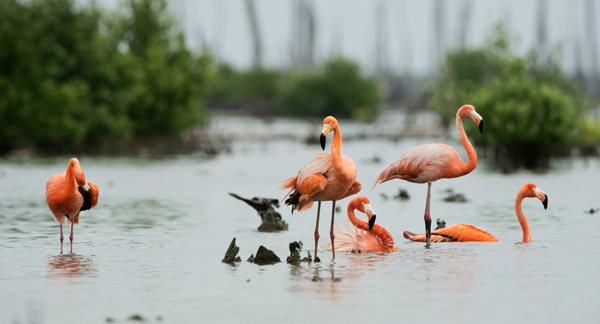The Holbrook Explorer

For Birders, Bahamas’ Outer Islands are Paradise
For Birders, Bahamas’ Outer Islands are Paradise
Visitors provide economic opportunity to support conservation
In the 30 minutes that Samuel Nelson has spent walking through Nicholls Town at the north end of Andros Island, he’s seen 17 species of birds. But his most-desired quarry has, thus far, eluded him. Following his ear, Nelson comes to a halt under a coconut palm tree, a grin spreading across his face. “There you are,” Nelson says, squinting up at the broad leaves. “I’ve got you now!”
 Inagua Island
Inagua Island
Photo by Mark A. Wilson
The most endangered bird in the Caribbean, the Bahama Oriole, has set up housekeeping under a palm leaf. Nelson is one of nine graduates of the Bahamas advanced course, which was conducted on Andros Island as well as Inagua Island, some 600 km to the southeast. (The basic class had 49 graduates.) Andros and Inagua are what Bahamians call “family islands.” On these less-developed islands, unemployment is high, poverty is increasing, and ambitious young adults are leaving for better opportunities elsewhere.
For birders, though, Andros is a paradise. Depending on the time of year, a visitor can see world-traveling shorebirds such as the Piping Plover or inland residents like the Great Lizard-Cuckoo. Other uncommon birds that spend at least a part of the year on Andros include the Bahama Yellowthroat, Bahama Swallow, Key West Quail-Dove, and West Indian Whistling-Duck.
 Caribbean Flamingos
Caribbean Flamingos
Inagua Island’s relative isolation and unusual habitats make it an attractive environment for the more than 200 species that winter on the island, including the world’s largest breeding colony of American Flamingos. The comeback of the flamingo, which was hunted almost to extinction, is one of the Caribbean’s greatest conservation success stories. “We had 15,000 to 20,000 hatchlings this year,” says Randolph “Casper” Burrows, one of three Inagua islanders to complete both the basic and advanced courses. “This means the total population is getting up close to 100,000 birds.”
In January, the Bahamas Ministry of Tourism made it a national priority to promote Andros and Inagua islands to birders. On both islands, bird lovers are beginning to show up more often, booking hotel rooms and hiring guides. Birding seems to be on the verge of becoming a significant alternative for local economic development.
“But I think the sustained effort has started to pay off,” says Scott Johnson, a science officer with the Bahamas National Trust who taught the advanced course. “Instead of conservationists using people to get what they want and then leaving, they are building relationships in the community. People don’t feel used; they feel that they’re benefitting from the work that’s being done.”
IF YOU GO – Join Audubon’s Matt Jeffery on the December 8, 2017 9-day Flyway Expedition: Birding and Conservation on Andros, Great Inagua and Abaco Islands.
 Reddish Egret
Reddish Egret
Guide Spotlight: Lehron “Roni” Rolle
“I didn’t notice birds much before,” says Lehron “Roni” Rolle. “But now I see and hear them everywhere.” Rolle did so well in the Audubon guide-training course that University of Maryland ornithologist Kevin Omland invited him to join the Bahama Oriole Project as a field assistant. On the first day of fieldwork in 2016, Rolle discovered an active nest with two adult Bahama Orioles and several fledglings. The nest was not in a coconut tree, as expected, but in a Caribbean pine. The discovery of pine-forest nesting overturned previous assumptions about Bahama Oriole breeding ecology. “With the finding we realized that there was more habitat and potentially more birds than anyone thought before,” says Rolle. “That was very good news for the bird.”
Abridged and used with permission of National Audubon Society
